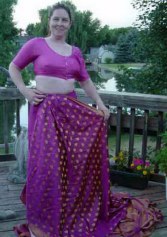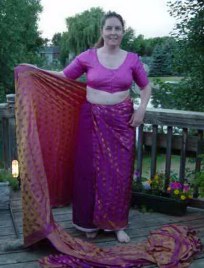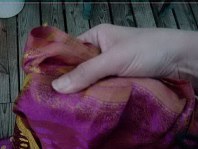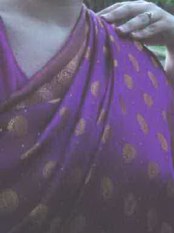
How to
wrap a Sari.
By Alaina
Blackram
This is one
easy way that every lady can use to wear a sari. Other variations can be
found in Sari, other books, and websites on the subject.
The sari has
been in constant use in the subcontinent of India for over 5000 years. In
that time, there have been over 1000 ways to wrap this sari. Each section and
town of India has its own way of wrapping the sari. Prior to the occupation
of the English, the Indians had only two parts to wearing a sari. After this
occupation, there are three. I agree with the third article, the petticoat,
as one can wear more sheer sarees and most importantly one will not be
embarrassed if the sari dislodges itself and flops to the ground.
First you
need all the parts to wear it. They consist of the Choli, the Petticoat and
the Sari fabric. A sari is traditionally 5-6 yards of fabric with one end
being a colourful fanciful pattern. A choli can be anything from the
many-pieced choli (Folkwear has a pattern), the open back choli which dancers
are fond of, or a fitted garment/top that a lady may wear to not expose skin.
The earliest choli were strips of cloth tied around the chest and fastened in
the back with a knot. The reason for it being a strip of cloth and not a
fitted top was due to not wanting to anger the gods by cutting a fabric.
(Sari)
The petticoat
can be many different varieties. They MUST have a firm waistband. Elastic
will not do. One step on the petticoat and down comes the sari. I have two
different types and while both are comfortable, I prefer one style for one
type of event and the other for things such as Pennsic. The modern Indian
petticoat is reminiscent to a skirt made up of many A-line panels. This has
the advantage of giving a slim silhouette and using less fabric. The other
petticoat I have is 4 yards of 45 wide fabric gathered onto a 3 inch wide
waistband. This is the one I use for hot weather or when I need to walk a
lot. This gives me a greater movement and more air movement.
Ok, now to
wrap the sari. This sari came from India and is made of 100% Silk. I am not
an expert, but merely a lady who likes wearing sarees. (and I did take these
photos myself. Sorry for the bad angles etc, I was trying to catch the last of
the daylight

 |
 |
 |
 |
First
layer, Choli and Petticoat
|
Look at
the sari. Find the Pullao (the fancy end) if you do not have one, check
for a more pronounced band of trim or design on one long side. The
fancy trim design will be the bottom. Put the pullao to your left.
|
Find
the RIGHT UPPER corner. Tie a knot in it.
|
Tuck
the knot into the waistband of the skirt.
|

Place
the rest of the sari on the
ground
and wrap once around
the
back. You can tuck in later
when
you are done
|
 Take and fold a few pleats in your hand 5-6. This will be your walking pleat. This gets tucked in the front of the sari and pinned with a safety pin to the petticoat. |

Tuck in pleats. There
will be some left over
to continue wrapping
|

Look down; this is what it basically looks like. |
 |
 |
 |
 |
|
Wrap
around the back once more and pull around to the front. Pleat this
widely with your hand. This will be your shoulder pleat.
|
Place
pleating on shoulder. To hold in place, use a safety pin from
underneath attached to the choli or a fashion pin
|
When
done, you will look all wrapped up like this
|
The
pullao goes over the back and drapes gracefully over the back. My
pullao drape is usually a bit longer, but I wanted to show the skirt
wrapping underneath
|
|
What
should I do with my hair? It is usually pulled straight back into a
pony tail, braided down the back or pulled away from the face in some
way.
|
How
about jewelry. Necklaces, earrings, bracelets are all appropriate.
Usually silver or gold. Bindi's in period have a religious meaning. (Bindi's
are a forehead decoration.
|
Henna
was primarily used for special occasions such as weddings. Elaborate
designs were drawn on the feet, hands, arms and face
|
As
Lallie says, Indian women never go gray, they just go red. Hence the
use of henna for hair colouring. It lasts for a few weeks and can stain
everything it touches when wet. But looks really smashing.
|